
Pellet Giant
February 10, 2011
By Jean Sorensen
Pinnacle Renewable Energy’s newest pellet plant arcs into production with the potential to be Canada’s largest pellet mill, producing 400,000 tonnes/year.
Pinnacle Renewable Energy’s newest pellet plant arcs into production with the potential to be Canada’s largest pellet mill, producing 400,000 tonnes/year. Located in Burns Lake, British Columbia, the $30-million facility is not only pushing the envelope in production, but is honing ways of using raw fibre resources, including roundwood, and landing a quality pellet on the doorstep of international buyers in Europe and Asia.
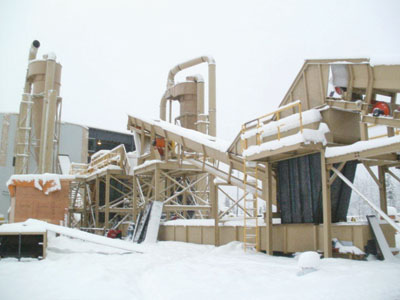
|
|
| Pinnacle Pellet’s newest facility is designed to handle diverse fibre feedstocks, from processed roundwood and harvesting residues to sawmill residuals. Photo: Gerry Clancy |
Pinnacle’s newest plant is its sixth achieved in just over a decade. Chief operating officer Leroy Reitsma says that Pinnacle has been evolving its own set of best practices and has a corporate culture of keeping a low profile. As it has grown from a smaller entity to one of North America’s largest pellet producers, it has become increasingly hard for the company to fly below the radar. Reitsma isn’t keen to talk about technology or to “disseminate the information, as we are paying a price for its development.” But, Pinnacle has progressed from its humble beginnings in 1989 with the Pinnacle Feed and Pellet plant in Quesnel, central British Columbia, to become a big-time player on a world stage.
The Burns Lake pellet plant will shoulder its way into the ranks of international heavy-weight mills when finished, although it’s smaller than the newly built $65-million 550,000 tonne/year Green Circle Bio Energy facility in the southern United States and the 900,000 tonne/year Vyborgskaya Cellulose pellet plant in Vybork, Russia, which was slated to begin production in late December 2010. However, the Burns Lake plant is considered large by international standards, bringing Pinnacle’s total production capacity to close to 1.2 million tonnes/year.
Designed for diverse feedstock
Reitsma says the ability to handle diverse fibre input is the initial element in a process designed for efficient delivery of energy. “At the end of the day, we are trying to build the most cost effective means of moving energy in wood form to the point of consumption,” he explains. “The distinct feature of this mill is that it will take all types of fibre: shavings, full-tree-length logs, any kind of wood that can be processed.” Pinnacle’s Meadowbank pellet plant—its fifth—processes a full array of sawmill and bush residuals. The Burns Lake mill is simply marching in stride to what has become a worldwide trend towards greater fibre diversity and roundwood use.
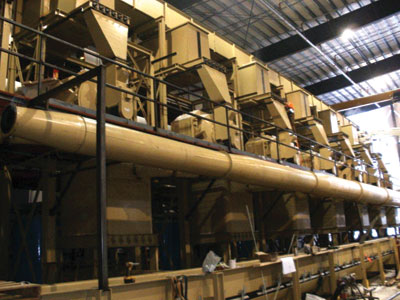
|
|
| The bank of eight Andritz-Sprout pellet mills will double in phase two, for a production capacity of 400,000 tonnes/year of wood pellets. Photo: Gerry Clancy |
Low-grade roundwood provides a supplemental fibre source for pellet plants should traditional sawmill residuals dwindle in down-turned markets. In Europe, pellet plants have been able to extend the fibre circle even further, using thinnings from new forests. While it may seem a long-term future consideration in the Burns Lake area, the viability of forests and operators is increasingly a focal point for local governments as mountain pine beetle wood is harvested.
Burns Lake Village Mayor Bernice Magee says the town reaps employment and expenditure benefits. “We are in a situation where we are looking at a declining timber supply (as beetle-killed wood is exhausted),” says Magee, adding that northern timber-dependent communities want to ensure the existing base is used wisely and the regrowth of new forests offers opportunity. “We are looking at ways to sustain ourselves, and pellet plants will help extend the use of the timber supply.”
The plant is located in the Bulkley-Nechako regional district and lies 24 km southeast of Burns Lake village. The site is approximately 40 ha, with buildings covering about 3 ha. It follows what has become a formula for Pinnacle: located close to essentials such as power, access routes, and materials. The main BC Hydro 138 kV power line to the northeast of the plant will feed into the small substation powering the plant. The Canadian National Railway line on the south boundary will include a 1.3-km rail spur able to accommodate up to 29 rail cars, with two rail loading bins suspended over the rail spur.
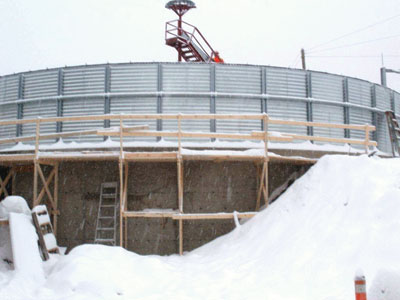 |
|
| The foundation for the first silo, one of two 5,000 m3 Westeel units, was poured in December 2010. Photo: Gerry Clancy
|
A nearby major highway links the mill to two Hampton Affiliates sawmills: Decker Lake Forest Products in Burns Lake, and Babine Forest Products’ mill, located 4 km southeast. The Decker and Babine sawmills have already shut their beehive burners, with waste material being sent to a storage site at the Burns Lake facility. Fibre such as sawdust, wood shavings, hog material, and low-quality roundwood could also come from other mills, as beehive burners are being phased out by 2016. Public information provided to the regional district from Pinnacle states that a second road is being used within the BC Hydro power line right of way, which will allow the Burns Lake operation to connect to the Augler FSR off-highway logging road used by Babine Forest Products. The off-highway route will allow Pinnacle to haul larger payloads such as logs and use large chip trucks.
“We are taking everything they can throw at us,” says new plant manager Gerry Clancy, a 33-year mill superintendent with Babine who came out of retirement to take on the challenge of starting a new, large production facility. Clancy says that forestry residuals would be processed at the logging site and roundwood at the plant using a Peterson grinder.
One challenge will be to minimize the dirt, rocks, and metal that come along with residual debris. Density separation equipment will allow stones and dirt to escape, and metal detectors will pick up stray metal. Spark detection and fire suppression systems from Clarke’s Industries are installed to enhance safety should contaminants make it into the pelleting process.
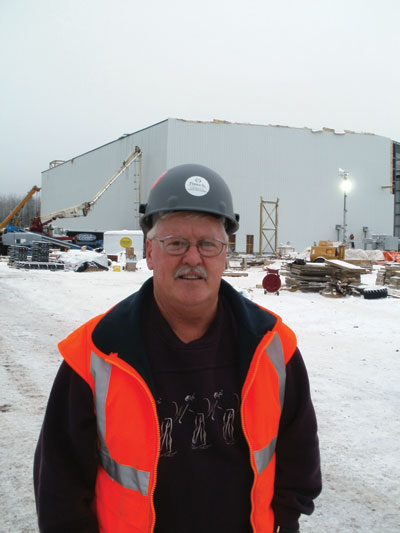 |
|
| Burns Lake plant manager Gerry Clancy came out of retirement for the challenge of the project.. Photo: Gerry Clancy
|
The plant also faces a challenge in mixing wet or green feedstock with drier sawmill residuals. The fibre will be dried from about 45% to 4.5–5% moisture content, which Clancy says will require gauging the moisture content of the feedstock at the front end and learning how to mix and dry it. The Meadowbank plant is already taking bush residues and mixing wet and dry feedstock, which is a plus in the learning curve. Burns Lake plant operators were in other Pinnacle mills during December 2010, learning the mixing processes, says Clancy. The ability to piggyback on other plant knowledge will shorten Pinnacle’s start-up time. “We will have operators from the Quesnel plant for the first little while,” he adds.
Reitsma says the plant’s MEC dryers are designed to handle controlled fluctuations in the moisture content. The key will be ensuring that the degree or rate of change is not “quicker than the dryer’s ability to respond.”
Plant framework
The plant’s design features a receiving area for the storage of residual fibre and roundwood storage; a hammermill facility to reduce the fibre material to a uniform size; a fibre drying facility, with process heat supplied by the plant’s own wood-fired burners; pellet mills to manufacture the wood pellets; storage silos to inventory the finished goods and a railcar loading facility. “The design of this plant is reflective of both the continued evolution of our process design and our 20 years of technical experience,” says Reitsma.
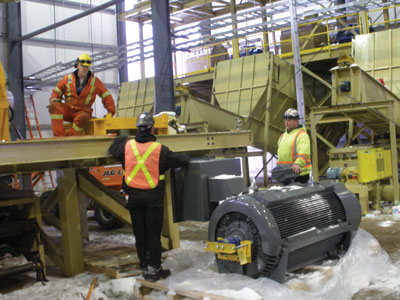 |
|
| Roger Hull (left) and Kerry Eglin (centre) of K2 Construction and Derek Dezamits (right) of Pinnacle Pellet stand near the outfeed from three Bliss hammermills. Photo: Wayne Clarke
|
The conceptual design, budget, and detailed engineering was done by Stolberg Engineering of Richmond, British Columbia, a company long known for engineering sawmills and one that has firmly niched into the province’s burgeoning pellet plant industry, starting with design work in 2000. This Burns Lake operation is the largest greenfield pellet plant the firm has designed, says John Ingram, president of Stolberg Engineering. “From an engineering perspective, a lot of our material handling experience from the sawmill industry was directly transferable to the pellet industry. On the plant process side, we worked closely with the client and the major equipment vendors.” Input from Pinnacle, which has evolved is own modular-style construction for the steel structure after five plants, ensured a fast start.
The plant features a fully integrated plant-wide electrical and proprietary control system, developed in cooperation with Cogent Industrial Technologies, that helps coordinate activities among the key production areas. Like Stolberg Engineering, Cogent is building a reputation for providing control systems to pellet plants. “We have a great relationship with Cogent,” says Reitsma. “Good things happen when you enjoy working together, and this is certainly the case in respect to Cogent.”
“The system boundaries are defined, the process layout accommodates operability and maintainability requirements, and the system adheres to plant standards,” says Cogent marketing representative Krystal Souza. “The Burns Lake facility will also include a state-of-the-art information technology and information management system to connect people to the plant equipment and process.” She notes that the system interface translates data into useful information that can be used by plant personnel to monitor and make adjustments for continuous improvements.
Service Electric, out of Quesnel, British Columbia, is the electrical contractor for the mill. It has also provided services to Pinnacle’s Meadowbank and Williams Lake operations.
Secondary processing & transport
Once through the primary breakdown phase and dried, the fibre undergoes further breakdown in a series of Bliss Industries hammermills. After conditioning, the material moves to Andritz Sprout-Bauer pellet mills. “We will have eight pelletizers in phase one,” says Clancy.
When the plant is at or near full production in phase two, 16 pelletizers will be operating.
Once the pellets are extruded, they pass through pellet coolers of Pinnacle’s own design and construction. They’re then transferred in bulk to one of two 5,000 m3 Westeel silos for storage prior to rail load-out and transport.
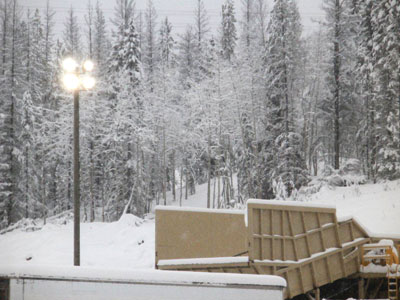 |
|
| The plant will initially start up with wood shavings, which will enter the system through this infeed, says plant manager Gerry Clancy. Photo: Gerry Clancy |
Eric Hilger, general manager of bulk sales and logistics for Pinnacle, says that pellets will be transported in covered hopper cars to port. Pinnacle is a partner in Houston Pellet Limited Partnership with Canfor and the Moricetown Indian Band, and the partnership has had a wood pellet terminal facility at Ridley since 2007. A number of advancements have been made to minimize pellet breakage and fines by using systems that are common in grain-handling facilities, particularly for brittle or fragile items such as dry beans, lentils, and chickpeas, says Hilger. Such grain-handling systems use a series of baffles that slow product flow by passing it from side to side or in a spiral as it flows downwards.
Jim Sawby of Alberta-based Skyway Grain Systems says that his company has been working with Pinnacle since 2004 for pellet handling and that it has been a learning experience in how to minimize product damage. Skyway supplied the two storage silos, the conveyance system to the bins, and the conveyance away from the silos. Skyway has also worked on pellet projects at Williams Lake, Houston, Meadowbank, and Ridley Island facilities.
The 400,000-tonne/year Burns Lake plant is a hefty leap forward in production for Pinnacle, whose other five plants, including Houston Pellet, have a combined total capacity of 760,000 tonnes/year, already making it a leader in Canada. When fully productive, the new plant will raise Pinnacles’ combined output to 1.16 million tonnes/year. British Columbia’s contribution to the world wood pellet market has risen from 64,000 tonnes/year in 1996 to 1.2–1.3 million tonnes/year in 2010, produced by about 10 pellet plants, according to Staffan Melin, research director of the Wood Pellet Association of Canada. By comparison, all plants in Canada combined ship approximately 1.8–2 million tonnes/year.
Print this page